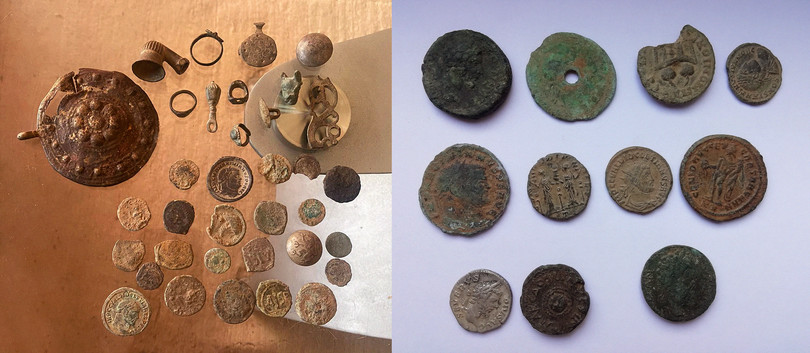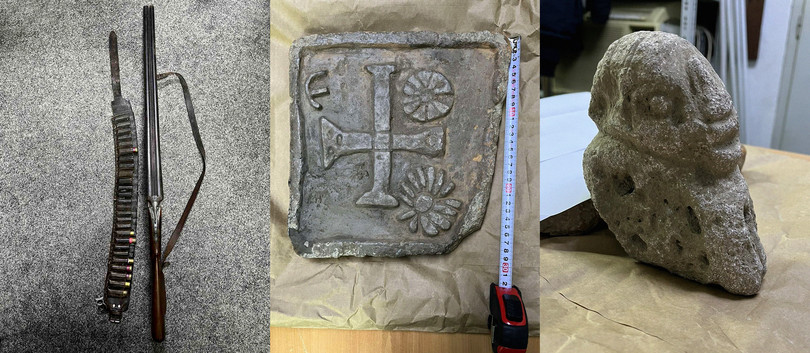Smuggling of antiquities threatens North Macedonia’s cultural heritage.
North Macedonia’s geographic position at the crossroads of historical civilizations makes it an attractive destination for people seeking to steal and traffic artefacts from archaeological sites. Organized groups operating in North Macedonia are believed to have good connections with foreign dealers who sell the stolen items on European black markets.1 There is also thought to be a growing market in Asia for artefacts stolen from North Macedonia.2 Independent investigative research suggests that over 100 000 items have been taken from historical sites in North Macedonia and transported around the world.3
Several incidents over the past decade demonstrate the threat posed to the rich cultural heritage of this Balkan country by illicit trafficking in cultural property. Most recently, in December 2022, 12 people were arrested in North Macedonia for being part of an organized criminal group involved in the theft of antiquities. The case, made public by the Interior Ministry on 13 December 2022, revealed that the criminal group had allegedly operated for a long time around the towns of Prilep, Strumica, Probishtip, Negotino, Kumanovo, Sveti Nikole, Kavadarci and Kocani. The police operation resulted in the seizure of various archaeological artefacts, including coins, metal objects and figurines, in addition to metal detectors, weapons and ammunition.4
The December arrests followed an incident in October 2022 in which four Ukrainians were arrested on suspicion of illegally digging for artefacts at one of North Macedonia’s richest archaeological sites – Isar, located near the village of Marvinci in the south.5 According to the official police statement, the suspects were arrested after officers caught them digging at the protected site, which features remnants of a temple and a stadium designed in the ancient Roman style. Two metal detectors, shovels and several excavated objects were found with suspects.
In 2021, the public prosecutor’s office charged eight people with illegally digging to extract items of cultural heritage. The accused, who were caught digging in unauthorized exploration and excavation locations on registered and unregistered archaeological sites near Skopje, Makedonski Brod, Kichevo and Veles, face between three and five years in prison. The investigators found artefacts hidden in the homes of the accused and unveiled a network of collaborators from Greece, Turkey, Albania, Croatia, Serbia and the US, who sold the artefacts to interested buyers.6
Trafficking in cultural property has long been a problem for law enforcement in North Macedonia. In 2010, the authorities arrested 48 people, including local politicians and archaeologists, in a nationwide operation against the illegal antiquities trade.7 Between then and 2014, the police carried out several major operations to expose artefact smugglers. The operations ‘Phalanga’ and ‘Apollo’ brought down a network of organized crime schemes that, in addition to illegally procured archaeological and historical objects, were offering icons for sale that had been stolen from churches. Investigations also showed that the suspects had used highly sophisticated equipment to locate metal objects buried in graves. According to official reports, the police found two highly valued icons, nine archaeological figures, three brooches, six pieces of jewellery, 17 coins and two ceramic vessels, as well as several pieces of equipment, including scanners and metal detectors, maps and sketches of archaeological sites, and weapons and ammunition.8

Cultural artefacts seized in police raids in North Macedonia.
Photo: Ministry of Internal Affairs of the Republic of North Macedonia
As operations ‘Phalanga’ and ‘Apollo’ revealed, religious art from North Macedonia’s churches is also being targeted for trafficking. There are some 20 000 icons from Macedonian churches and monasteries that have been trafficked out of the country into private collections around the world. For example, in 2009, six icons of St John the Theologian Kaneo of inestimable value were taken from Ohrid and returned by INTERPOL, only to be stolen again and never found.9 Icons stolen from the monastery of St Naum, just south of Ohrid, are also still missing.10
In 2014, Serbian daily Blic reported that more than 10 valuable religious objects had been stolen from churches in North Macedonia over the previous decade. The paper cited Ohrid-based curator Milcho Georgievski, who pointed out that artefacts stolen from Macedonian churches and archaeological sites are being sold at secret auctions in Western Europe and ending up in private collections. The process of restitution or return is practically impossible.
Nevertheless, the police continue with attempts to prosecute traffickers and recover artefacts. In 2021, Macedonian police reported 160 stolen archaeological objects and icons to the INTERPOL base. Some of the icons and items that were reported stolen have been published on the Interior Ministry’s website.11 Also in 2021, police arrested a group of eight men in North Macedonia accused of participating in multiple illegal excavations across the country with the aim of selling antiquities abroad.12 According to the official report, police raided homes and other premises linked with the suspects at 10 locations in the southern town of Bitola and the north-western town of Tetovo. They seized a large number of artefacts, including ancient figurines and jewellery, as well as firearms and metal detectors.

North Macedonian police recovered historical artefacts in a raid on a suspected antiquities smuggling operation in December 2022.
Photo: Ministry of Internal Affairs of the Republic of North Macedonia
The serious problem of the illegal artefact and cultural heritage trade in North Macedonia appears to be part of a global trend. According to the Assistant Director-General for Culture at the UN Educational, Scientific and Cultural Organization (UNESCO), the illicit trade reportedly represents five per cent of the estimated €45 billion antiquities market.13 The substantial value of the artwork and antiquities market, which has skyrocketed since the 1990s, can be attributed in part to technological development, with buyers and sellers now connecting online, as well as increased globalization that allows greater communication and ease of travel.14 Growing interconnectivity has also helped criminals explore the dark side of finding and collecting artefacts and cultural heritage. This trend, according to UNESCO, is ongoing, not just in established cultural heritage sites but also in places ‘where we didn’t know antiquities existed’.15
At the same time, the issue of stolen cultural property is gaining greater international attention. For example, in late 2022, the 11th Conference of the Parties to the UN Convention against Transnational Organized Crime (UNTOC) adopted a resolution on the trafficking in cultural property, which is not specifically covered by the convention and its protocols.16 The resolution focuses on strengthening crime prevention and criminal justice responses to protect cultural property and calls on member states to categorize trafficking in cultural property as a serious crime (as defined by the UNTOC) to facilitate international cooperation. The resolution also requests that states take measures to raise public awareness, mount media campaigns and build institutional capacity.17
These two things – public awareness and international cooperation – are essential for disrupting the illegal artefact trade in North Macedonia. A lack of awareness and neglect of cultural heritage accompanied by weak institutions enables criminals to exploit opportunities that are often overlooked or even facilitated by law enforcement and government ministers due to corruption or poor governance. Combating trafficking in cultural property therefore requires a multi-sectoral approach, involving civil society; the criminal justice system; the private sector (particularly those involved in logistics, IT platforms and auction houses); and historians, archaeologists and government agencies responsible for protecting cultural heritage.
Given that the illegal trade in cultural artefacts is not occurring in a vacuum, but rather makes use of existing organized crime routes, the response should be holistic and ‘glocal’. This would involve attempts to understand specific local conditions and to strengthen local resilience, while analyzing the ecosystem in which this crime operates, including the transnational enablers, drivers and networks.
Finally, the issue should be seen and addressed within the broader context of disrupting illicit economies. The Organization for Security and Co-operation in Europe – currently chaired by North Macedonia – working with INTERPOL has observed that the illegal trade in cultural goods is sometimes linked to the illegal arms trade, human trafficking and migrant smuggling.18 Similarly, UNESCO has taken the position that the illicit trafficking of cultural property contributes significantly to the funding of terrorism, organized crime and money laundering. In 2017, the UN Security Council formally recognized that threats to cultural heritage are a major security issue that the international community has a direct responsibility to protect against.19 Given the security dynamics in the Western Balkans regarding organized crime, international terrorism and ongoing geopolitical competition, the region should make addressing the illegal trade in artefacts a priority.
Notes
-
Interview with archaeologist Andrijana Petkovska, Skopje, 15 January 2023. ↩
-
Interview with investigative journalist Dejan Misevski, Skopje, 19 January 2023. ↩
-
Macedonian artefacts and icons on illegal markets in Asia, Sloboden Pečat, 14 January 2021, https://www.slobodenpecat.mk/en/makedonski-artefakti-i-ikoni-na-nelegalnite-pazari-vo-azija. ↩
-
Сузбиена 12-члена организирана криминална група – диви копачи на културното наследство, Sloboden Pečat, 13 December 2022, https://www.slobodenpecat.mk/videofoto-suzbiena-12-chlena-organizirana-kriminalna-grupa-divi-kopachi-na-kulturnoto-nasledstvo. ↩
-
North Macedonia: 4 Ukrainians arrested at archeological site, Associated Press, 22 October 2022, https://apnews.com/article/science-arrests-09109e6ccfc8a493a8062143dafb7d2e. ↩
-
Public Prosecutor’s Office of North Macedonia, Обвинение за осуммината диви копачи и трговци со македонско културно наследство, 25 March 2022, https://jorm.gov.mk/obvinenie-za-osumminata-divi-kopachi-i-trgovczi-so-makedonsko-kulturno-nasledstvo. ↩
-
Macedonia cracks down on illicit antiquities trade, Auction Central News, 25 June 2010, https://www.liveauctioneers.com/news/top-news/crime-and-litigation/macedonia-cracks-down-on-illicit-antiquities-trade. ↩
-
Пресуда Фаланга 2: Сите обвинети се прогласени за виновни, Паско Кузман доби три години затвор, Академик, 24 July 2014, https://akademik.mk/presuda-za-falanga-site-obvineti-se-proglaseni-za-vinovni-pasko-kuzman-dobi-tri-godini-zatvor-4. ↩
-
Крадците од Канео однеле ситни пари, Вечер, 4 October 2009, https://vecer.mk/uncategorized/крадците-од-канео-однеле-ситни-пари. ↩
-
Macedonian artefacts and icons on illegal markets in Asia, Sloboden Pečat, https://www.slobodenpecat.mk/en/makedonski-artefakti-i-ikoni-na-nelegalnite-pazari-vo-azija. ↩
-
Ministry of Interior Affairs of the Republic of North Macedonia, ИНТЕРПОЛ, https://mvr.gov.mk/page/interpol. ↩
-
North Macedonia holds 8 for antiquities smuggling, illegal digs, Kathimerini, 30 September 2021, https://www.ekathimerini.com/news/1168888/north-macedonia-holds-8-for-antiquities-smuggling-illegal-digs. ↩
-
Guy Shone and Cyril Fourneris, Art and crime – the dark side of the antiquities trade, Euronews, 13 April 2022, https://www.euronews.com/next/2022/04/13/art-and-crime-the-dark-side-of-the-antiquities-trade. ↩
-
Organization for Security and Co-operation in Europe, How illicit trade in art and artefacts is robbing us blind, 5 October 2016, https://www.osce.org/magazine/271951. ↩
-
Zeynep Boz, Fighting the illicit trafficking of cultural property, UNESCO, 2018, https://unesdoc.unesco.org/ark:/48223/pf0000266098?posInSet=1&queryId=69eeca8c-383e-4b4f-b795-0e3dad58dab5. ↩
-
Ian Tennant, Resolutions on environmental crime and trafficking in cultural property, Global Initiative Against Transnational Organized Crime, 6 December 2022, https://globalinitiative.net/analysis/untoc-resolution-environmental-cultural-property-crimes. ↩
-
Ibid. ↩
-
Organization for Security and Co-operation in Europe, How illicit trade in art and artefacts is robbing us blind, 5 October 2016, https://www.osce.org/magazine/271951. ↩
-
Zeynep Boz, Fighting the illicit trafficking of cultural property, UNESCO, 2018, https://unesdoc.unesco.org/ark:/48223/pf0000266098?posInSet=1&queryId=69eeca8c-383e-4b4f-b795-0e3dad58dab5. ↩
